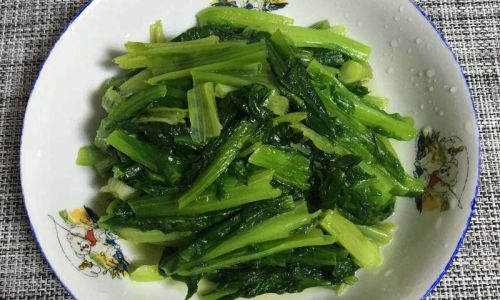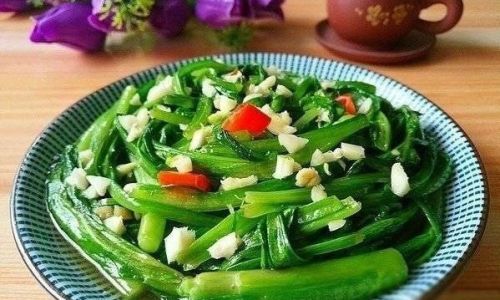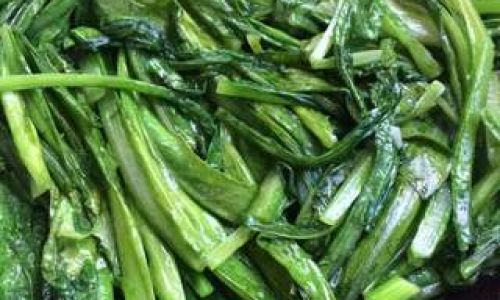Introduction: The Simplicity and Elegance of Stir-Fried Oilseed Mustard Greens
In the vast culinary landscape of Chinese cuisine, stir-frying stands as a testament to the art of cooking with precision and minimalism. Among the myriad of vegetables that benefit from this rapid cooking technique, oilseed mustard greens (also known as youmai or Chinese flowering cabbage) shine brightly. Their delicate flavor, vibrant green hue, and nutritional benefits make them a staple in many Chinese households. This guide aims to demystify the process of how to make a perfect dish of stir-fried oilseed mustard greens, ensuring that even the most novice cook can achieve restaurant-quality results at home.
Understanding Oilseed Mustard Greens
Before diving into the cooking process, it’s crucial to understand the unique characteristics of oilseed mustard greens. These greens are part of the Brassicaceae family, which includes broccoli, cabbage, and kale. They have a slightly bitter taste when raw but transform into a mild, slightly sweet, and tender vegetable when cooked properly. Their leaves are typically dark green, with a slightly crinkled texture that adds visual appeal to any dish.

Nutritionally, oilseed mustard greens are a powerhouse. They are rich in vitamins A, C, and K, as well as dietary fiber, calcium, and antioxidants. Regular consumption can contribute to improved heart health, enhanced immune function, and better digestion.
Preparing Your Ingredients and Equipment
The beauty of stir-frying lies in its simplicity and speed. However, achieving the perfect balance of flavors and textures requires careful preparation. Here’s a detailed breakdown of what you’ll need:
Ingredients:
- Fresh oilseed mustard greens: About 1 pound (450 grams), thoroughly washed and drained
- Garlic: 2-3 cloves, minced
- Fresh ginger: A small piece, about 1 teaspoon minced
- Cooking oil: A neutral oil like canola or vegetable oil is ideal, but you can also use sesame oil for added flavor (about 2 tablespoons)
- Salt: To taste
- White pepper: A pinch (optional, for a subtle heat)
- Oyster sauce or soy sauce: About 1 teaspoon (optional, for added umami)
- Sugar: A pinch (optional, to balance bitterness and enhance sweetness)
Equipment:
- A large wok or a heavy-bottomed skillet
- A sharp knife for chopping
- A cutting board
- A spatula or wooden spoon for stirring
- A colander or strainer for draining the greens
- Tongs or chopsticks (optional, for easier handling of greens in the wok)
Step-by-Step Guide to Stir-Frying Oilseed Mustard Greens
Preparation of the Greens
Begin by selecting fresh oilseed mustard greens. Look for leaves that are dark green and free from yellowing or wilting. Rinse the greens thoroughly under cold running water to remove any dirt or pesticides. Use your hands to gently rub the leaves together if necessary to dislodge stubborn particles. Once cleaned, drain the greens well in a colander. Pat them dry with paper towels if necessary to remove excess water, which could cause steaming rather than stir-frying.
Preparing the Aromatics
While the greens are draining, mince the garlic and ginger. These aromatics will form the foundation of flavor in your dish. The sulfur compounds in garlic and the gingerol in ginger not only enhance the taste but also provide health benefits such as anti-inflammatory properties.
Heating the Wok or Skillet

Place your wok or heavy-bottomed skillet over high heat. Preheat it for at least 2-3 minutes until it becomes very hot. The high heat is crucial for achieving the signature seared flavor and tender-crisp texture of stir-fried vegetables.
Adding the Oil
Once the wok is hot, pour in the cooking oil and swirl it around to coat the entire surface evenly. The oil should shimmer but not smoke. If it starts to smoke, reduce the heat slightly.
Sautéing the Aromatics
Add the minced garlic and ginger to the hot oil. Stir-fry them for about 10-15 seconds until they become fragrant but do not let them burn. This quick sauté releases their essential oils and flavors, creating a delicious aroma that will permeate the greens.
Adding the Greens
Working quickly, add the drained oilseed mustard greens to the wok. They may initially fill the wok, but as they cook, they will wilt and reduce in volume. Use a spatula or wooden spoon to toss and stir the greens continuously. The goal is to coat each leaf with the hot oil and ensure even cooking.
Seasoning and Stir-Frying
As soon as the greens start to wilt, sprinkle in a pinch of salt. If using, add a pinch of white pepper, a teaspoon of oyster sauce or soy sauce, and a pinch of sugar. Continue to stir-fry the greens over high heat for another 2-3 minutes. The cooking time will depend on the thickness of the greens and your preferred level of doneness. Aim for a tender-crisp texture, where the greens are cooked through but still retain some firmness.
Adjusting the Flavor
Taste a small piece of green to check for seasoning. Adjust with more salt, pepper, or sauce if needed. Remember, stir-fries are best enjoyed with flavors that are bold but balanced.

Serving
Once the greens are cooked to your liking, remove the wok from heat. Transfer the stir-fried oilseed mustard greens to a serving dish immediately to prevent overcooking. Garnish with a sprinkle of freshly ground black pepper or a drizzle of sesame oil if desired.
Tips for Perfect Stir-Fried Oilseed Mustard Greens
- Use High Heat: Stir-frying requires high heat to sear the vegetables and lock in their flavors and nutrients. Ensure your wok or skillet is preheated before adding oil.
- Don’t Crowd the Wok: Overfilling the wok will reduce the heat and cause the greens to steam rather than stir-fry. If necessary, cook in batches.
- Stir Constantly: Continuous stirring ensures even cooking and prevents burning. Use a spatula or wooden spoon that can reach the bottom and sides of the wok.
- Season Early: Adding salt and other seasonings early helps draw out moisture from the greens, promoting faster cooking and flavor absorption.
- Don’t Overcook: Oilseed mustard greens should be tender-crisp. Overcooking will turn them mushy and lose their vibrant color.
- Use Fresh Ingredients: The quality of your ingredients makes a significant difference. Fresh greens and aromatics will yield the best results.
Exploring Variations and Enhancements
While the basic recipe for stir-fried oilseed mustard greens is straightforward, there are numerous ways to elevate this dish:
- Protein Additions: Stir in slices of pork belly, shrimp, or tofu for a heartier meal.
- Nuts and Seeds: Sprinkle with toasted sesame seeds, chopped peanuts, or cashews for added crunch and texture.
- Sauces and Condiments: Experiment with different sauces like hoisin, chili oil, or a splash of rice vinegar to suit your taste preferences.
- Herbs and Spices: Incorporate fresh herbs like cilantro, mint, or basil for a burst of freshness. Add a pinch of five-spice powder or cumin for a unique twist.
- Garnishes: Enhance visual appeal with garnishes such as sliced red chili peppers, green onions, or julienned carrots.
Conclusion: A Culinary Journey in Every Stir-Fry
Stir-frying oilseed mustard greens is not just a cooking technique; it’s a culinary journey that combines precision, speed, and an appreciation for fresh ingredients. By following the steps outlined in this guide, you can transform a humble bunch of greens into a vibrant, flavorful dish that showcases the essence of Chinese stir-frying. Whether you’re a seasoned chef or a home cook exploring new recipes, the art of stir-frying oilseed mustard greens offers a rewarding culinary experience that celebrates the simplicity and elegance of fresh, wholesome food.
As you perfect your stir-frying technique, remember that cooking is as much about intuition and personal preference as it is about following recipes. Experiment with different seasonings, cooking times, and ingredient combinations to find what resonates with your taste buds. With each stir-fry, you’ll gain confidence and deepen your understanding of this timeless cooking method, ultimately creating dishes that are as satisfying to prepare as they are to eat.
Happy stir-frying!





0 comments